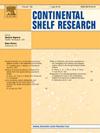冷战的回声
IF 2.1
3区 地球科学
Q2 OCEANOGRAPHY
引用次数: 0
摘要
卡拉海是核武器试验造成放射性核素污染的地区,因为它毗邻新泽姆利亚群岛上的核试验场。根据该海域 15 个沉积岩芯中 137Cs 和 210Pb 的垂直分布情况,可以重建 137Cs 进入海洋沉积物的时间顺序。重建是基于 210Pbex 的年龄深度模型 RUS2023(Rusakov 等人,2024 年),并考虑了沉积物的粒度组成和吸附能力。我们的研究表明,新泽姆利亚海槽沉积物中较高的 137Cs 浓度与 1961-63 年核武器试验活跃时期(约 9.0 ± 1.6 Bq kg-1)以及 1986 年叶尼塞湾河口沉积物中较高的 137Cs 浓度(85.2 ± 3.2 Bq kg-1)相对应。20 世纪 80 年代异常高的通量是 137Cs 通量的叠加,它是全球尘降(切尔诺贝利痕量)的结果,也是位于叶尼塞河流域的区域源释放放射性核素的结果。这两个事件都与海洋沉积物的沉积和堆积速度加快有关。1961-63 年,这是核爆炸导致沉积物释放到大气中的结果;20 世纪 80 年代,则是河流径流导致沉积物供应增加的结果。目前,在入海沉积物通量减少的背景下,新谢姆利亚和叶尼塞河仍然是海洋沉积物中 137Cs 的主要供应来源。喀拉海近期沉积物的背景值为 2.0 Bq kg-1。本文章由计算机程序翻译,如有差异,请以英文原文为准。
Echoes of a Cold War
The Kara Sea was an area of radionuclide contamination as a result of nuclear weapons testing, since it is located in close proximity to the nuclear test site on the Novaya Zemlya archipelago. The vertical distribution of 137Cs and 210Pb in 15 sediment cores from the sea made it possible to reconstruct the chronology of 137Cs entry into marine sediments. The reconstruction was based on the age-depth model RUS2023 (Rusakov et al., 2024) for 210Pbex, taking into account the grain-size composition and sorption capacity of sediments. Our study showed that higher 137Cs concentrations in sediments of the Novaya Zemlya Trough correspond to the time of active nuclear weapons testing in 1961–63 (about 9.0 ± 1.6 Bq kg‒1), as well as in estuarine sediments of the Yenisei Bay in 1986 (85.2 ± 3.2 Bq kg‒1). The abnormally high flux in 1980s represents the superposition of 137Cs fluxes as a result of global fallout (Chernobyl trace) and as a result of the release of radionuclide from regional source located in the Yenisei River catchment. Both of these events are associated with increased the sedimentation and mass accumulation rates of marine sediments. In 1961‒63, this was a consequence of the release of sediment into the atmosphere due to nuclear explosions, and in the 1980s, as a result of an increase in sediment supply with river runoff. Currently, against the backdrop of a decrease in sediment fluxes into the sea, Novaya Zemlya and Yenisei River remain the main sources of 137Cs supply to marine sediments. Background values for recent sediments in the Kara Sea are <2.0 Bq kg‒1.
求助全文
通过发布文献求助,成功后即可免费获取论文全文。
去求助
来源期刊

Continental Shelf Research
地学-海洋学
CiteScore
4.30
自引率
4.30%
发文量
136
审稿时长
6.1 months
期刊介绍:
Continental Shelf Research publishes articles dealing with the biological, chemical, geological and physical oceanography of the shallow marine environment, from coastal and estuarine waters out to the shelf break. The continental shelf is a critical environment within the land-ocean continuum, and many processes, functions and problems in the continental shelf are driven by terrestrial inputs transported through the rivers and estuaries to the coastal and continental shelf areas. Manuscripts that deal with these topics must make a clear link to the continental shelf. Examples of research areas include:
Physical sedimentology and geomorphology
Geochemistry of the coastal ocean (inorganic and organic)
Marine environment and anthropogenic effects
Interaction of physical dynamics with natural and manmade shoreline features
Benthic, phytoplankton and zooplankton ecology
Coastal water and sediment quality, and ecosystem health
Benthic-pelagic coupling (physical and biogeochemical)
Interactions between physical dynamics (waves, currents, mixing, etc.) and biogeochemical cycles
Estuarine, coastal and shelf sea modelling and process studies.
 求助内容:
求助内容: 应助结果提醒方式:
应助结果提醒方式:


